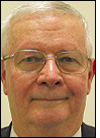Aug 15, 2006By Peter Cole
RFID systems won't be widely adopted until tags are cheap and reliable. The need for low-cost tags inevitably requires them to be passive—that is, to contain no internal power source. Most of the communications applications with which we are familiar (radio, TV, mobile phones) make use of battery or household current at either end of the propagation link.
It would be a mistake to expect passive tags to perform in a manner similar to these well-known applications. When RFID tags are passive, they are normally only just working, or only just not working, as the case may be. There is no room for poor performance, so they must be designed and deployed to operate optimally. To accomplish this, we need to understand electromagnetic fields.
The electromagnetic fields emitted by radios, TVs and cell phones are propagating fields, which carry energy away from the radiating source, and diminish in intensity relatively slowly with distance. But near the transmitting antenna there are also energy storage fields, which exchange energy with parts of the antenna. These fields are stronger near the antenna and diminish in intensity more rapidly with distance than the propagating fields do.
RFID systems can make use of either the propagating fields or the local energy storage fields. An RFID tag does not know and does not care where the field that excites it comes from: If it senses it, it will use it. So it is necessary to study the local, or near, energy storage fields, and the propagating, or far, fields. Of particular interest is the question: Which one will be stronger at the tag position?
At the University of Adelaide's Auto-ID Lab, we have focused our research on how to describe such fields and how to couple to them, particularly when the tags are small, which many applications need. In describing the fields, we note that there are electric fields, which will place forces on charges, and magnetic fields, which will move magnets. The fundamental discoveries of Faraday and Maxwell showed that each, when changing, can produce the other.
From studying these concepts, we learn that electric fields are sourced by charges that are on conductors and can easily be terminated by charges on another conductor. Magnetic fields flow around in closed curves and can be bent to go around conductors, but cannot be terminated by them.
Closely related to these concepts are the electromagnetic field boundary conditions for fields near conductors. When an electric field meets a nearby conductor, it does so at right angles, whereas when a magnetic field approaches a nearby conductor, it slides past tangentially. So, if you put a tag antenna on metal, it had better be designed for the type and direction of field you expect to find there.
Our analysis has led to the definition of appropriate measures of strength of exciting field and tag sensitivity to fields that can be applied to both near and far fields. These measures are called reactive power density per unit volume and coupling volume.
Our conclusions are:
- When considering power transfer to tag antennas, it is essential to know whether near or far field excitation is in play.
- If an antenna is very small, only the intense fields of near-field excitation will likely overcome its disability of very low efficiency regarding radiated fields.
- Antennas are not sensitive to fields of all types and directions. An antenna must be designed to couple to the type of field that exists near the object to be tagged.
- The object itself can significantly modify the nature of the field in its vicinity.
Our research also has derived various designs for both transmitter and tag antennas for various contexts.
Peter Cole is the research director of the Auto-ID Lab at Adelaide, Australia, which is part of the School of Electrical and Electronic Engineering at the University of Adelaide.


